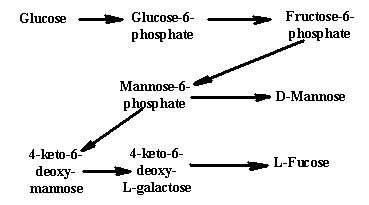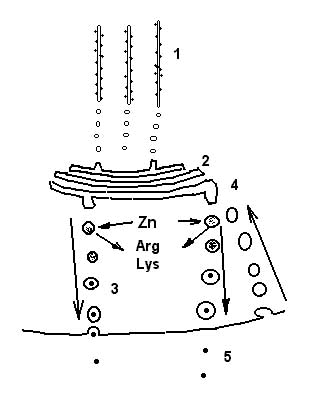

| Ig G | Ig A | Ig M | Ig D | Ig E | |
| The contents of the carbohydrates in molecule of immunoglobulin, %1 | 2,9 | 7,5 | 11,8 | - | 10,7 |
| Concentration of immunoglobulin, g/100 mL1 | 0,6-1,7 | 0,14-0,42 | 0,05 - 0,19 | 0,003 - 0,04 | 0,00001 - 0,00014 |
| The half-life1 | 5,8 | 5,1 | 2,8 | 2,5 | |
| Speed of synthesis, mg/kg of weight / day1 | 33 | 24 | 6,7 | 0,4 | 0,016 |
| Quantity synthesized of the immunoglobulin for one day with weight of 70 kg, mg | 2310 | 1680 | 469 | 28 | 1 |
| Requirement of sugars for synthesis of the immunoglobulin, mg | 67,0 | 126,0 | 55,3 | - | 0,1 |
| Requirement of human organism of weight 70 kgs in the mannose and fucose for synthesis of immunoglobulin, mg2 | 21,7 | 40,9 | 17,9 | - | 0,03 |
| Parameter | Group of the patients | |||
| 1 | 2 | 3 | 4 | |
| Age of the patients, years | 23,5 + 6,4 | 30,3 + 6,9 | 50,2 + 5,5 | 44,2 + 4,8 |
| Duration of disease | 11,0 + 3,9 | 10,2 + 4,6 | 8,7 + 5,2 | 4,3 + 3,5 |
| Doze of insulin, E on 1 kg of weight per day | 0,7 + 0,2 | 0,5 + 0,1 | - | - |
| Hb A1c, % | 7,5 + 1,1 | 12,5 + 0,8 | 7,1 + 0,9 | 10,1 + 1,0 |
| IRI, mE./mL | 11,2 + 7,1 | 8,0 + 8,0 | 30,1 + 11,2 | 60,4 + 20,5 |
| GC, mmol/L | 5,0 + 0,3 | 6,0 + 0,5 | 6,4 + 0,2 | 7,5 + 0,4 |
| LPVLD, g/L | 1,8 + 0,3 | 2,2 + 0,1 | 2,2 + 0,2 | 2,4 + 0,1 |
| LPHD, g/L | 1,3 + 0,3 | 0,9 + 0,2 | 1,5 + 0,3 | 1,5 + 0,3 |
| TG, mmol/L | 1,7 + 0,5 | 2,5 + 0,3 | 1,9 + 0,4 | 1,9 + 0,4 |
| CA | 2,9 + 0,1 | 5,6 + 0,2 | 3,3 + 0,2 | 3,3 + 0,2 |
| Food products | Investigated parameter, g/100 g of a product | |||||||
| Hemicellulose | Glucose | Galactose | Mannose | Fucose | Fructose | Saccharose | Lactose | |
| Macaroni | 0,5 | 0,09 | - | - | - | 0,03 | - | - |
| Rice | 4,1 | 0,08 | - | - | - | 0,07 | - | - |
| Farine | 0,5 | 0,04 | - | - | - | 0,06 | - | - |
| Pearl barley | 2,1 | 0,20 | - | 0,20 | - | 0,18 | - | - |
| Groats millet | 1,9 | 0,22 | - | 0,10 | - | 0,24 | - | - |
| Buckwheat | 3,3 | 0,20 | - | 0,23 | - | 0,04 | - | - |
| Oatmeal | 3,3 | 0,09 | - | 0,10 | - | 0,06 | - | - |
| Bread of rye | 6,4 | 0,12 | 0,24 | 0,40 | - | 0,15 | 0,02 | - |
| Bread wheaten | 3,3 | 0,14 | 0,10 | 0,03 | - | 0,10 | 0,24 | - |
| Green peas | 0,3 | 0,10 | - | - | - | - | 2,8 | - |
| Squash | 0,3 | 2,5 | - | - | - | 1,6 | 0,5 | - |
| Cabbage | 0,5 | 2,6 | - | - | - | 1,6 | 0,4 | - |
| Carrots | 0,3 | 2,5 | - | - | - | 1,0 | 3,5 | - |
| Water-melon | 0,1 | 2,4 | - | - | - | 4,3 | 2,0 | - |
| Kefir | - | - | 0,10 | - | - | - | - | 3,6 |
| Milk | - | 0,02 | 0,01 | - | - | - | - | 4,5 |
| Sour cream | - | 0,03 | 0,05 | - | - | - | - | 3,1 |
| Cottage cheese | - | 0,01 | 0,01 | - | - | - | - | 0,5 |
| Apples | 0,4 | 2,2 | - | - | - | 5,5 | 2,0 | - |
| Cucumbers | 0,1 | 1,3 | 1,1 | - | - | 0,3 | 0,03 | - |
| Garden radish | 0,6 | 1,5 | - | - | - | 1,2 | 0,5 | - |
| Salade | 0,1 | 0,1 | - | - | - | - | 0,1 | - |
| Tomatoes | 0,1 | 1,6 | - | - | - | 1,2 | 0,7 | - |
| Onions green | 0,2 | 1,3 | - | - | - | 1,2 | 0,5 | - |
| Sugar | Investigated parameter, mg% | ||||
| Norm | Group of the patients | ||||
| 1 | 2 | 3 | 4 | ||
| Fucose | Traces | 0,00 | 0,00 | Traces | 0,18 + 0,02 |
| Mannose | 9,00 + 0,50 | 0,00 | 0,00 | Traces | Traces |
| Fructose | 0,11 + 0,01 | 7,10 + 0,49 | 18,58 + 1,2 | 6,49 + 0,3 | 9,86 + 1,0 |
| X1 | 0,21 + 0,05 | 0,00 | 1,27 + 0,04 | 0,00 | 2,98 + 0,1 |
| Glucose | 87,18 + 2,5 | 127,08 + 5,4 | 402,46 + 20,6 | 103,94 + 3,6 | 204,84 + 6,7 |
| X2 | 0,02 + 0,01 | 0,00 | 0,00 | 1,69 + 0,2 | 13,76 + 1,3 |
| X3 | 0,05 + 0,02 | 0,00 | 0,00 | 0,00 | 7,52 + 0,8 |
| X4 | 0,01 + 0,01 | 0,00 | 0,00 | 0,00 | 0,00 |
| X5 | 0,03 + 0,01 | 13,85 + 1,2 | 8,48 + 1,1 | 9,55 + 0,9 | 8,64 + 1,0 |
| X6 | 0,22 + 0,04 | 0,08 + 0,02 | 0,00 | 0,18 + 0,05 | 1,78 + 0,09 |
| X7 | 0,00 | 0,00 | 0,00 | 0,00 | 1,04 + 0,2 |
| Sum total | 96,83 + 5,1 | 148,20 + 8,3 | 434,75 + 24,6 | 121,85 + 6,2 | 250,60 + 12,5 |
| P | <0,05 | <0,01 | < 0,05 | < 0,01 |
| Sugar | II types | I types | ||||
| SI( 10 years) | SI( 10 years) | SS( 8 years) | SD is revealed | SD( 6 years) | SD( 3 years) | |
| Fucose | Traces | 0,00 | 0,00 | 0,00 | 0,00 | 0,00 |
| Mannose | Traces | 0,00 | 0,00 | 0,00 | 0,00 | 0,00 |
| Fructose | 6,49 | 8,00 | 7,10 | 12,95 | 14,40 | 18,58 |
| X1 | - | 1,98 | - | - | 0,87 | 1,27 |
| Glucose | 103,94 | 399,24 | 127,08 | 382,83 | 275,35 | 402,46 |
| X2 | 1,69 | - | - | 7,06 | 5,11 | - |
| X3 | - | - | - | - | 4,17 | - |
| X4 | - | 2,36 | - | - | 2,17 | - |
| X5 | 9,55 | 8,56 | 13,85 | 5,23 | 15,97 | 8,48 |
| X6 | 0,18 | - | 0,08 | - | 0,88 | - |
| X7 | - | - | - | - | 0,85 | - |
| Sum total... | 121,85 | 420,33 | 148,20 | 408,07 | 312,77 | 434,75 |
| Sugar and them metabolic | Investigated parameter, mg% | ||||
| Norm | Group of the patients | ||||
| 1 | 2 | 3 | 4 | ||
| Pyruvic acid | 0,01+0,01 | 0,37 + 0,12 | 0,15 + 0,09 | 0,40 + 0,09 | 0,24 + 0,08 |
| X1 | 0,01 + 0,005 | 0,08 + 0,01 | 0,00 | 0,26 + 0,08 | 0,07 + 0,01 |
| X2 | 0,00 | 0,01 + 0,01 | 0,00 | 0,00 | 0,01 + 0,003 |
| X3 | 0,00 | 0,00 | 0,00 | 0,00 | 0,00 |
| Wine acid | 0,02 + 0,01 | 0,11 + 0,03 | 0,00 | 0,11 + 0,05 | 0,03 + 0,004 |
| Fructose | 0,00 | 0,00 | 0,45 + 0,10 | 0,00 | 0,15 + 0,01 |
| Glucose | 0,00 | 0,00 | 34,85 + 2,30 | 0,14 + 0,04 | 17,32 + 1,40 |
| X5 | 0,00 | 0,00 | 0,25 + 0,08 | 0,00 | 0,08 + 0,03 |
| Citric acid | 0,02 + 0,01 | 0,23 + 0,05 | 0,00 | 0,10 + 0,01 | 0,50 + 0,01 |
| X6 | 0,00 | 0,00 | 0,05 + 0,01 | 0,01 + 0,01 | 0,07 + 0,01 |
| X7 | 0,02 + 0,01 | 0,28 + 0,04 | 0,46 + 0,12 | 0,60 + 0,08 | 0,09 + 0,01 |
| X8 | 0,00 | 0,00 | 0,00 | 0,20 + 0,01 | 0,01 + 0,003 |
| Sum total | 0,08 + 0,01 | 1,08 + 0,04 | 36,23 + 1,5 | 1,82 + 0,21 | 18,11 + 0,90 |
| P | <0,01 | <0,01 | < 0,01 | < 0,01 |
| Sugar | II types | I types | ||||
| SI( 10 years) | SI( 10 years) | SS( 8 years) | SD(For the first time is revealed) | SD( 6 years) | SD( 3 years) | |
| Pyruvic acid | 0,68 | 0,39 | 0,04 | 0,05 | 0,02 | - |
| X1 | 0,43 | 0,19 | 0,03 | - | - | - |
| X2 | 0,07 | 0,07 | - | - | - | - |
| X3 | - | 0,01 | - | - | - | - |
| Wine acid | 0,10 | 0,09 | - | - | - | - |
| X4 | - | - | 0,02 | 0,17 | - | 0,25 |
| Fructose | 0,02 | 0,08 | 0,50 | 5,84 | - | 9,81 |
| Glucose | 0,14 | 0,15 | 55,02 | 38,40 | 39,40 | 42,11 |
| X5 | - | 0,02 | - | - | - | 9,17 |
| Citric acid | 0,10 | 0,44 | 0,93 | 0,50 | 0,72 | - |
| X6 | - | 0,03 | - | - | - | - |
| X7 | 0,22 | 0,31 | 0,44 | 1,07 | 0,27 | 0,73 |
| X8 | 0,61 | 0,12 | - | 0,16 | - | 0,75 |
| Sum total... | 2,30 | 1,90 | 56,99 | 46,19 | 40,41 | 63,65 |